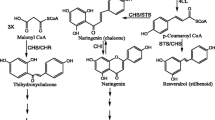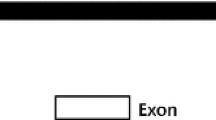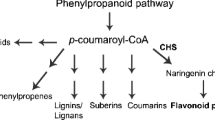Abstract
Key message
Our results showed that GbIRL1 belongs to the PCBER protein family. Besides, IRL1 gene was a novel gene regulating lignin change and also effecting the accumulation of flavonoids in Ginkgo.
Abstract
A cDNA encoding the IFR-like protein was isolated from the leaves of Ginkgo biloba L., designated as GbIRL1 (Accession no. KC244282). The cDNA of GbIRL1 was 1,203 bp containing a 921 bp open reading frame encoding a polypeptide of 306 amino acids. Comparative and bioinformatic analyses revealed that GbIRL1 showed extensive homology with IFLs from other gymnosperm species. Phylogenetic tree analysis revealed that GbIRL1 shared the same ancestor in evolution with other PCBERs protein and had a further relationship with other gymnosperm species. The recombinant protein was successfully expressed in E. coli strain with pET-28a vector. The vitro enzyme activity assay by HPLC indicated that recombinant GbIRL1 protein could catalyze the formation the TDDC, IDDDC from DDDC, DDC. Tissue expression pattern analysis showed that GbIRL1 was constitutively expressed in stem and roots, especially in the parts of the pest and fungal infection, with the lower expression being found in 1- or 2-year old stem. The increased expression of GbIRL1 was detected when the seedlings were treated with Ultraviole-B, ALA, wounding and ethephon, abscisic acid, salicylic acid. Correlation analysis between GbIRL1 activity and flavonoid accumulation during Ginkgo leaf growth indicated that GbIRL1 might be the rate-limiting enzyme in the biosynthesis pathway of flavonoids in Ginkgo leaves. Results of RT-PCR analysis showed that the transcription level of change in GbIRL1 power correlated with flavonoid contents, suggesting IRL1 gene as a novel gene regulating lignin change and also effecting the accumulation of flavonoids in Ginkgo.







Similar content being viewed by others
Abbreviations
- bp:
-
Base pair
- HPLC:
-
High performance liquid chromatography
- IPTG:
-
Isopropyl b-d-thiogalactoside, C9H18O5S
- IFR:
-
Isoflavone reductase
- IRL:
-
Isoflavone reductase-like protein
- IRLP:
-
IRLgene promoter
- ORF:
-
Open reading frame
- PCBER:
-
Phenylcoumaran benzylic ether reductases
- PCR:
-
Polymerase chain reaction
- RACE:
-
Rapid amplification of cDNA ends
- QRT-PCR:
-
Real-time quantitative PCR
- SD:
-
Standard deviation
- SDS-PAGE:
-
Sodium dodecyl sulfate polyacrylamide gel electrophoresis
- UV:
-
Ultraviolet
References
Ardi R, Kobiler I, Jacoby B, Keen N, Prusky D (1998) Involvement of epicatechin biosynthesis in the activation of the mechanism of resistance of avocado fruits to Colletotrichum gloeosporioides. Physiol Mol Plant P 53(5–6):269–285
Bashandy T, Taconnat L, Renou JP, Meyer Y, Reichheld JP (2009) Accumulation of flavonoids in an ntra ntrb mutant leads to tolerance to UV-C. Mol Plant 2(2):249–258
Brandalise M, Severino FE, Maluf MP, Maia IG (2009) The promoter of a gene encoding an isoflavone reductase-like protein in coffee (Coffea arabica) drives a stress-responsive expression in leaves. Plant Cell Rep 28(11):1699–1708
Cheng S, Wang Y, Fei Y, Zhu G (2004) Studies on the effects of different treatments on flavonoids contents in Ginkgo biloba leaves and their regulating mechanism. J Fruit Sci 21(2):116–119 (in Chinese)
Cheng S, Wang Y, Liu W, Chen K (2005) Effects of plant growth regulators on phenylalanine ammonia-lyase activities in leaves of Ginkgo biloba in vitro. J Plant Resour Environ 14(1):20–22 (in Chinese)
Cheng H, Li L, Cheng S, Cao F, Wang Y, Yuan H (2011) Molecular cloning and function assay of a chalcone isomerase gene (GbCHI) from Ginkgo biloba. Plant Cell Rep 30(1):49–62
Dinkova-Kostova AT, Gang DR, Davin LB, Bedgar DL, Chu A, Lewis NG (1996) (+)-pinoresinol/(+)-lariciresinol reductase from Forsythia intermedia. J Biol Chem 271(46):29473–29482
Dixon RA, Steele CL (1999) Flavonoids and isoflavonoids—a gold mine for metabolic engineering. Trends Plant Sci 4(10):394–400
Eulgem T, Rushton PJ, Schmelzer E, Hahlbrock K, Somssich IE (1999) Early nuclear events in plant defence signalling: rapid gene activation by WRKY transcription factors. EMBO J 18(17):4689–4699
Ferrer JL, Austin M, Stewart C Jr, Noel J (2008) Structure and function of enzymes involved in the biosynthesis of phenylpropanoids. Plant Physiol Bioch 46(3):356–370
Fofana B, McNally DJ, Labbé C, Boulanger R, Benhamou N, Séguin A, Bélanger RR (2002) Milsana-induced resistance in powdery mildew-infected cucumber plants correlates with the induction of chalcone synthase and chalcone isomerase. Physiol Mol Plant P 61(2):121–132
Gaffney T, Friedrich L, Vernooij B, Negrotto D, Nye G, Uknes S, Ward E, Kessmann H, Ryals J (1993) Requirement of salicylic acid for the induction of systemic acquired resistance. Science 261(5122):754–756
Gang DR, Kasahara H, Xia ZQ, Vander Mijnsbrugge K, Bauw G, Boerjan W, Van Montagu M, Davin LB, Lewis NG (1999) Evolution of plant defense mechanisms: relationships of phenylcoumaran benzylic ether reductases to pinoresinol lariciresinol and isoflavone reductases. J Biol Chem 274(11):7516–7527
Gapper C, Dolan L (2006) Control of plant development by reactive oxygen species. Plant Physiol 141(2):341–345
Hano C, Martin I, Fliniaux O, Legrand B, Gutierrez L, Arroo RRJ, Mesnard F, Lamblin F, Lainé E (2006) Pinoresinol–lariciresinol reductase gene expression and secoisolariciresinol diglucoside accumulation in developing flax (Linum usitatissimum) seeds. Planta 224(6):1291–1301
Harmer SL, Hogenesch JB, Straume M, Chang HS, Han B, Zhu T, Wang X, Kreps JA, Kay SA (2000) Orchestrated transcription of key pathways in Arabidopsis by the circadian clock. Science 290(5499):2110–2113
Hayat S, Ali B, Ahmad A (2007) Salicylic acid: biosynthesis, metabolism and physiological role in plants, Springer publication, Netherlands, pp 1–14
Hotta Y, Tanaka T, Takaoka H, Takeuchi Y, Konnai M (1997) Promotive effects of 5-aminolevulinic acid on the yield of several crops. Plant Growth Regul 22(2):109–114
Jansson S, Meyer-Gauen G, Cerff R, Martin W (1994) Nucleotide distribution in gymnosperm nuclear sequences suggests a model for GC-content change in land-plant nuclear genomes. J Mol Evol 39(1):34–46
Karamloo F, Wangorsch A, Kasahara H, Davin LB, Haustein D, Lewis NG, Vieths S (2001) Phenylcoumaran benzylic ether and isoflavonoid reductases are a new class of cross-reactive allergens in birch pollen, fruits and vegetables. Eur J Biochem 268(20):5310–5320
Kim ST, Cho KS, Kim SG, Kang SY, Kang KY (2003) A rice isoflavone reductase-like gene, OsIRL, is induced by rice blast fungal elicitor. Mol Cells 16(2):224–231
Kim SG, Kim ST, Wang Y, Kim SK, Lee CH, Kim KK, Kim JK, Lee SY, Kang KY (2010) Overexpression of rice isoflavone reductase-like gene (OsIRL) confers tolerance to reactive oxygen species. Physiol Plantarum 138(1):1–9
Kirk TK, Obst JR (1988) Lignin determination. Method Enzymol 161(5):87–101
Kozak M (1984) Compilation and analysis of sequences upstream from the translational start site in eukaryotic mRNAs. Nucleic Acids Res 12(2):857–872
Kush A, Goyvaerts E, Chye ML, Chua NH (1990) Laticifer-specific gene expression in Hevea brasiliensis (rubber tree). Proc Natl Acad Sci USA 87(5):1787
Lers A, Burd S, Lomaniec E, Droby S, Chalutz E (1998) The expression of a grapefruit gene encoding an isoflavone reductase-like protein is induced in response to UV irradiation. Plant Mol Biol 36(6):847–856
Lescot M, Déhais P, Thijs G, Marchal K, Moreau Y, Van de Peer Y, Rouzé P, Rombauts S (2002) PlantCARE, a database of plant cis-acting regulatory elements and a portal to tools for in silico analysis of promoter sequences. Nucleic Acids Res 30(1):325–327
Lu X, Liu Y, An J, Hu H, Peng S (2010) Isolation of a cinnamoyl CoA reductase gene involved in formation of stone cells in pear (Pyrus pyrifolia). Acta Physiol Plant 10(7):1–7
Lütcke H, Chow K, Mickel F, Moss K, Kern H, Scheele G (1987) Selection of AUG initiation codons differs in plants and animals. EMBO J 6(1):43–49
Meer I, Stuitje A, Mol J, Verma D (1993) Control of plant gene expression: regulation of general phenylpropanoid and flavonoid gene expression, CAB Direct, United Kingdom, pp 125–155
Min T, Kasahara H, Bedgar DL, Youn B, Lawrence PK, Gang DR, Halls SC, Park HJ, Hilsenbeck JL, Davin LB (2003) Crystal structures of pinoresinol–lariciresinol and phenylcoumaran benzylic ether reductases and their relationship to isoflavone reductases. J Biol Chem 278(50):50714–50723
Nam MH, Heo EJ, Kim JY, Kim SI, Kwon KH, Seo JB, Kwon O, Yoo JS, Park YM (2003) Proteome analysis of the responses of Panax ginseng CA Meyer leaves to high light: use of electrospray ionization quadrupole-time of flight mass spectrometry and expressed sequence tag data. Proteomics 3(12):2351–2367
Nishihara E, Takahashi K, Nakata N, Tanaka K, Watanabe K (2001) Effect of 5-aminolevulinic acid (ALA) on photosynthetic rate, hydrogen peroxide content, antioxidant level and active oxygen-scavenging enzymes in spinach (Spinacia oleracea L.). J Jpn Soc Hortic Sci 70(3):346–352
Nishihara E, Kondo K, Parvez MM, Takahashi K, Watanabe K, Tanaka K (2003) Role of 5-aminolevulinic acid (ALA) on active oxygen-scavenging system in NaCl-treated spinach (Spinacia oleracea). J Plant Physiol 160(9):1085–1091
Nishiuchi T, Shinshi H, Suzuki K (2004) Rapid and transient activation of transcription of the ERF3 gene by wounding in tobacco leaves. J Biol Chem 279(53):55355–55361
Paiva NL, Edwards R, Sun Y, Hrazdina G, Dixon RA (1991) Stress responses in alfalfa (Medicago sativa L.). Molecular cloning and expression of alfalfa isoflavone reductase, a key enzyme of isoflavonoid phytoalexin biosynthesis. Plant Mol Biol 17(4):653–667
Petrucco S, Bolchi A, Foroni C, Percudani R, Rossi GL, Ottonello S (1996) A maize gene encoding an NADPH binding enzyme highly homologous to isoflavone reductases is activated in response to sulfur starvation. Plant Cell 8(1):69–80
Schmittgen TD, Livak KJ (2008) Analyzing real-time PCR data by the comparative CT method. Nat Protoc 3(6):1101–1108
Shen YY, Wang XF, Wu FQ, Du SY, Cao Z, Shang Y, Wang XL, Peng CC, Yu XC, Zhu SY (2006) The Mg-chelatase H subunit is an abscisic acid receptor. Nature 443(7113):823–826
Shoji T, Winz R, Iwase T, Nakajima K, Yamada Y, Hashimoto T (2002) Expression patterns of two tobacco isoflavone reductase-like genes and their possible roles in secondary metabolism in tobacco. Plant Mol Biol 50(3):427–440
Skriver K, Mundy J (1990) Gene expression in response to abscisic acid and osmotic stress. Plant Cell 2(6):503
Smith J, Luo Y (2004) Studies on molecular mechanisms of Ginkgo biloba extract. Appl Microbiol Biot 64(4):465–472
Suzuki S, Umezawa T (2007) Biosynthesis of lignans and norlignans. J Wood Sci 53(4):273–284
Tamura K, Dudley J, Nei M, Kumar S (2007) MEGA4: molecular evolutionary genetics analysis (MEGA) software version 4.0. Mol Biol Evol 24(8):1596–1599
Tiemann K, Inzé D, Van Montagu M, Barz W (1991) Pterocarpan phytoalexin biosynthesis in elicitor-challenged chickpea (Cicer arietinum L.) cell cultures. Purification, characterization and cDNA cloning of NADPH: isoflavone oxidoreductase. Eur J Biochem 200(3):751–758
Turley R (2008) Expression of a phenylcoumaran benzylic ether reductase-like protein in the ovules of Gossypium hirsutum. Biol Plantarum 52(4):759–762
van Beek TA (2002) Chemical analysis of Ginkgo biloba leaves and extracts. J Chromatogr A 967(1):21–55
Vander Mijnsbrugge K, Beeckman H, De Rycke R, Van Montagu M, Engler G, Boerjan W (2000) Phenylcoumaran benzylic ether reductase, a prominent poplar xylem protein, is strongly associated with phenylpropanoid biosynthesis in lignifying cells. Planta 211(4):502–509
Wang Y, Cheng S (2002) Studies on the effects of regulating measures on the flavonoids contents in Ginkgo biloba leaves. Hubei Agric Sci 25(5):103–105 (in Chinese)
Wang LJ, Jiang WB, Huang BJ (2004a) Promotion of 5-aminolevulinic acid on photosynthesis of melon (Cucumis melo) seedlings under low light and chilling stress conditions. Physiol Plantarum 121(2):258–264
Wang LJ, Wang ZH, Li ZQ, Liu H, Liu WQ, Chen ZY, Yan P, Sun DQ (2004b) Effect of 5-aminolevulinic acid on enhancing apple fruit coloration. J Fruit Sci 21(6):512–515 (in Chinese)
Xie Z, Zhang ZL, Zou X, Huang J, Ruas P, Thompson D, Shen QJ (2005) Annotations and functional analyses of the rice WRKY gene superfamily reveal positive and negative regulators of abscisic acid signaling in aleurone cells. Plant Physiol 137(1):176–189
Xu F (2008) Cloning and expression of GbPAL and GbANS genes and effect of ALA on the content of flavonoids in Ginkgo biloba. Doctor. Shandong Agricultural University, Shandong
Xu F, Cai R, Cheng S, Du H, Wang Y (2008a) Molecular cloning, characterization and expression of phenylalanine ammonia-lyase gene from Ginkgo biloba. Afr J Biotechnol 7(6):721–729
Xu F, Cheng H, Cai R, Li LL, Chang J, Zhu J, Zhang FX, Chen LJ, Wang Y, Cheng SH (2008b) Molecular cloning and function analysis of an anthocyanidin synthase gene from Ginkgo biloba, and its expression in abiotic stress responses. Mol Cells 26(6):536–547
Xu F, Li L, Zhang W, Cheng H, Sun N, Cheng S, Wang Y (2012) Isolation, characterization, and function analysis of a flavonol synthase gene from Ginkgo biloba. Mol Biol Rep: 1–12
Zhu Q, Guo T, Sui S, Liu G, Lei X, Luo L, Li M (2009) Molecular cloning and characterization of a novel isoflavone reductase-like gene (FcIRL) from high flavonoids-producing callus of Fagopyrum cymosum. Acta Pharmacol Sin 44(7):809–819
Acknowledgments
This work was supported by the Natural Science Foundation of China (30971974 and 31270717), Economic Forest Germplasm Improvement and Comprehensive Utilization of Resources of Hubei Key Laboratories (20011BLKF238 and 2011BH0030), and University-industry Cooperation Fund of Hubei Educational Office (CXY2009B009).
Author information
Authors and Affiliations
Corresponding authors
Additional information
Communicated by H. Judelson.
Electronic supplementary material
Below is the link to the electronic supplementary material.
Rights and permissions
About this article
Cite this article
Hua, C., Linling, L., Feng, X. et al. Expression patterns of an isoflavone reductase-like gene and its possible roles in secondary metabolism in Ginkgo biloba . Plant Cell Rep 32, 637–650 (2013). https://doi.org/10.1007/s00299-013-1397-2
Received:
Revised:
Accepted:
Published:
Issue Date:
DOI: https://doi.org/10.1007/s00299-013-1397-2




